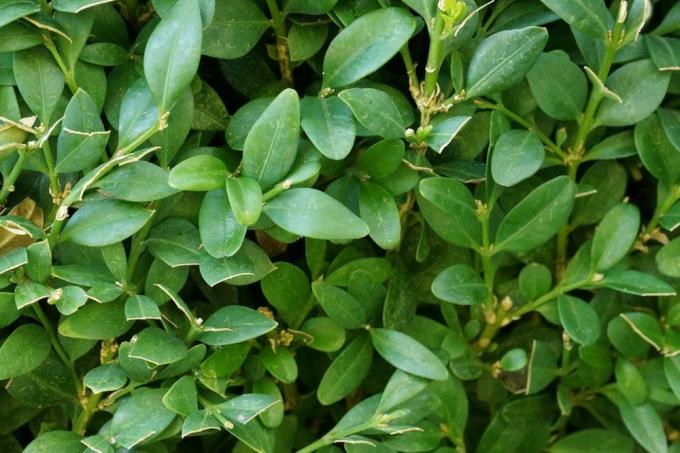
table of contents
- Poison in the boxwood
- Effect of the poison
- Symptoms of poisoning
- person
- animal
- Precautions
- animals
- Boxwood as a medicinal plant
The box tree, sometimes also spelled Buxbaum, is a very popular plant for the ornamental garden in this country. Whether in the shape of a ball, a square or cut as an animal shape, the tree will always find a nice place in the garden. And a box hedge is the ideal privacy screen for many. As pretty as the plant is to look at, it is not suitable for human or animal consumption.
Poison in the boxwood
Buchs belongs to the genus Buxus. Today there are more than sixty varieties of common boxwood, botanically Buxus sempervirens. They differ in leaf color, size, shape and distance as well as in their growth shape and speed. What all varieties have in common is that all of their parts are poisonous. Since the leaves have a very bitter taste, they are usually not swallowed, but rather spit out again immediately. The ingestion of larger amounts and thus poisoning is rare, but you should still be careful.
The popular box is very poisonous. With around 70 alkaloids, it contains a true cocktail of poison. The proportion of all alkaloids in leaves and bark is three percent. The flowers and fruits of the boxwood are also highly poisonous. In addition to the main active ingredient cyclobuxin (buxin), other poisons were also found in the plant.
This includes:
- Buxantine
- Buxanin
- Buxandrine

Effect of the poison
The poison cocktail in the box unfolds its effect when parts of the plant are eaten. Simply touching the plant does not cause poisoning. However, you should wear gloves when working on the plant and always wash your hands thoroughly after cutting.
Symptoms of poisoning
As with all poisons, the degree of poisoning with boxwood depends on the dose, body size and weight. Therefore z. B. small animals are more at risk than children. Fortunately, since adults only swallow small amounts of Buxbaum, if at all, poisoning that has led to death is not known or known in this country. documented.
person
Nevertheless, if the worst comes to the worst, you should not hesitate to call the appropriate emergency number. A check by a doctor or veterinarian gives you security. Because in the worst case, boxwood poisoning can lead to death.

Symptoms of poisoning caused by the boxwood are:
- Vomit
- nausea
- diarrhea
- cramps
- Paralysis
- Tremble
- Drop in blood pressure up to and including circulatory collapse
Have children nibbled on the book or its fruit, keep calm. First and foremost, you should get the child to spit out any leftovers. In contrast to other poisonings, there is no need to give an antidote to boxwood poisoning. The body can even break down small amounts of the poison itself and the symptoms subside after a while.
A first measure is the administration of medicinal charcoal. It binds the toxins in the stomach. Do not make the child vomit. It is more effective if the child drinks small amounts of tea or water. We do not recommend milk. It is not an antidote. Under certain circumstances, it can even promote the absorption of toxins in the intestines.
animal
The symptoms of poisoning in pets are similar to those in humans. If your darling has nibbled on the book, the poison has an arousing effect at first, but then quickly paralyzes and lowers blood pressure. Symptoms include stomach and intestinal irritation, vomiting and diarrhea, as well as cramps and tremors.
Since it is difficult to determine how much pets have eaten, see a veterinarian immediately if symptoms occur. Do not try to make the pet vomit, better offer them water to drink. This dilutes the poison in the stomach and intestinal tract.

As with humans, the same applies to pets: young animals can tolerate a smaller amount of poison than adult animals. For a four kilo cat, around 20 grams of Buchs are fatal, for a 30 kilo dog 150 grams. The rule of thumb is: 5 grams of the plant per kilogram of body mass in dogs or Cats are deadly.
Precautions
To avoid poisoning with Buchs in the first place, you should take a few precautionary measures for your own balcony or terrace. Garden to be taken.
- place on balcony or terrace out of the reach of children and pets
- it is better to refrain from planting in the garden with small children
However, boxwood is not only found in your own or neighbour's garden as a box hedge. The slow-growing plant is also often used as a border for graves or as an ornamental plant in parks or near playgrounds. The following applies to the public area: make sure that Buchs is nearby.
animals
The plant is poisonous not only to children but also to pets. Animals at risk include not only dogs and cats, but also rabbits or guinea pigs and other smaller caged animals. To protect your darlings from poisoning, the following precautionary measures should be taken.
- no box tree in the garden if pets are present
- Fencing the box in an animal-safe way
- Cats shouldn't be able to climb up
- Set up outdoor enclosures for rabbits and guinea pigs at a great distance from the Buchs

Boxwood as a medicinal plant
Despite its toxicity, the book was used as a medicinal plant in ancient times. It was mainly used as a remedy for coughs and stomach and intestinal diseases. Today the plant is no longer used as a remedy because its dosage is extremely problematic. An overdose leads to vomiting and cramps. It can even be fatal. Only in homeopathy is Buxus occasionally prescribed for rheumatism.



